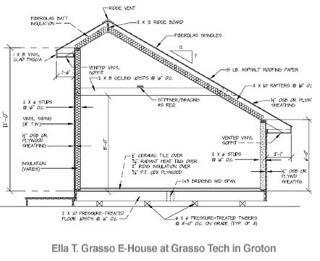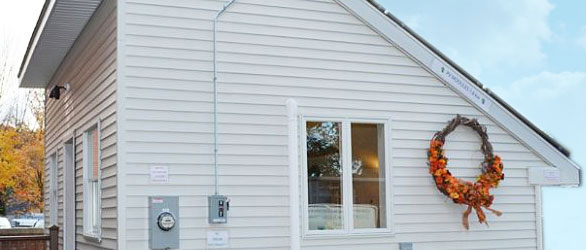
The Connecticut Technical Education and Career System's ("CTECS") E-House Initiative created on-site laboratories for high school students and trade instructors where hands-on learning and green workforce development flourish.
Each E-House was designed and built by CTECS students and instructors featuring high-efficiency and clean, renewable energy technologies. Working on the E-House helped to prepare Connecticut's technical high school students to enter the green workforce. The E-Houses serve as energy efficiency learning laboratories with examples of insulation and construction practices of the past and present in an energy efficiency time capsule.
The first E-House was opened at E.C. Goodwin Technical High School in New Britain on September 20, 2011. Since then, six more E-Houses have opened at technical high schools throughout Connecticut.
What is an E-House?
An Energy Efficient Building
All of CT Technical High Schools' E-Houses are built with design techniques that have energy efficiency in mind. Some of the E-Houses are 16' x 20' structures that use Solar PV and Solar Thermal that provide electricity and hot water for the building. Heating for these E-Houses comes from a high efficiency boiler. Other E-Houses (20' x 30') also have geo-thermal heating and cooling systems and a mechanical room that allows for real-world scenarios in the classroom.
A Learning Laboratory
Lighting:
A variety of lighting options are displayed throughout each E-House, from inefficient incandescent bulbs to highly efficient LEDs.
Building Analysis/Weatherization:
During construction of the E-Houses a variety of windows were tested, and students used the Blower Door Test, Fluke-Infrared Gun, and smoke stick testing to detect air leakage. A variety of energy efficient framing techniques and window options were installed throughout the building. Different types of insulation are showcased to demonstrate the variety of materials that are used to insulate a home.
Solar PV:
Solar PV panels which provide electricity for the structure and an electric car charging station, some of which are feed excess energy back into the grid. Electricity production can be monitored via the web.
Solar Thermal:
Solar Thermal panels are hooked up to a water heater. Hot water is fed back to the host school for use.
Heat Pumps:
High efficiency ductless mini split heat pumps use an environmentally friendly refrigerant.
All systems can be used for future instruction through demonstration, maintenance, and upgrades.




